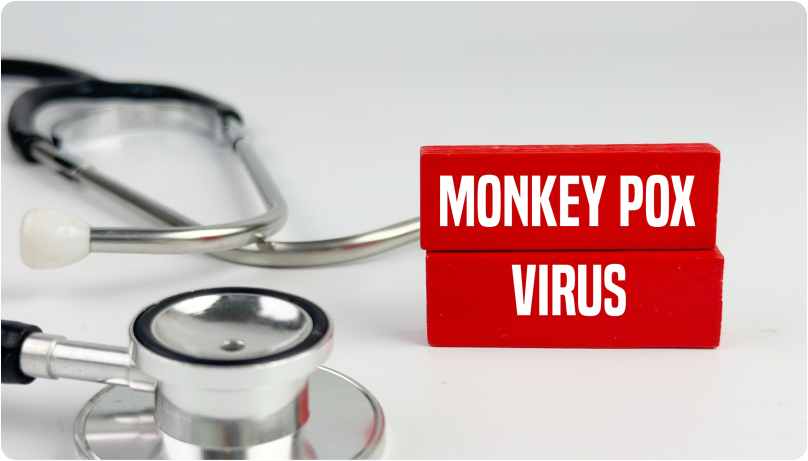Preventive Care
What You Need to Know About Mpox Virus
27 August 2024
Share

What You Need to Know About Mpox Virus
In recent weeks, Mpox (formerly known as Monkeypox) has been drawing attention as a significant public health concern. While Mpox is relatively rare, understanding the disease, its symptoms, transmission methods, and preventive measures is crucial for maintaining health and safety.
About Mpox
Mpox is a disease caused by the monkeypox virus. There are various strains of monkeypox. The recent WHO declared Mpox public health emergency is caused by Clade 1 while the previous multi-country outbreak in 2022 was caused by Clade 2.
Transmission of Mpox
- Direct Contact: The virus can be transmitted through direct contact with the skin lesions or bodily fluids of an infected person. This includes touching the rash, sores, or scabs.
- Respiratory Droplets: Prolonged face-to-face contact with an infected person can lead to transmission through respiratory droplets.
- Animal Contact: Interaction with infected animals, suspected to be small rodents or non-human primates such as monkeys, can also be a source of infection. This is less common but still a potential risk risk through bite or scratch from an infected animal, bush meat preparation, or direct contact with the blood, body fluids, or skin or mucosal lesions of infected animals
Common symptoms to look out for
GPs are often the first point of contact for patients hence recognising the symptoms early is crucial for initiating appropriate care and preventing the spread of the virus. Dr Adrian Poh, Medical Director at HMI OneCare Clinic emphasises that while Mpox can present with symptoms similar to other viral infections, there are specific features to look for:
- Fever: If present, may occur early on with flu-like symptoms, and may be accompanied by chills and body aches.
- Headache and Muscle Aches: Usually also reported in the early stages.
- Swollen Lymph Nodes: A well-documented distinctive feature that may be present in some patients. This may possibly help distinguish from other common viral infections.
Symptoms usually appear within 21 days after exposure.

A distinctive symptom of Mpox
Dr Kok Wai Leong, Dermatologist at HMI Medical Centre highlights that the rash is a distinctive feature of Mpox. It can start on the face and spread to other body parts, including the mouth and genital area. The rash follows several stages:
- Flat Spots or small bumps: These appear on the skin and can be itchy or painful
- Fluid-Filled Sores or blisters: These develop and may cause discomfort
- Crusting: The sores eventually crust over with scabs before healing
As Mpox presents with skin symptoms similar to those of other diseases, a full clinical examination is required in order to differentiate it from other conditions such as chicken pox, measles, herpes or hand-food-mouth disease (HFMD), which may present with rashes. The treatment plan should include medications for the skin, and close follow up with the doctor to manage complications and post-infection care.

Prevention measures
Effective prevention of Mpox involves various strategies to reduce the risk of infection and transmission. Here are key measures to consider:
Avoid close contact with those you know diagnosed with or has suspected Mpox. Stay informed about Mpox in your area, know the symptoms and check yourself regularly, practice good personal hygiene such as washing your hands often with soap and water or hand sanitizer, avoid sharing common items that may be contaminated with bodily fluids.
Practice safe sex, including avoiding high-risk sexual activities such as having multiple partners or engaging in casual sex. Barrier protection should be used when engaging in high-risk sexual practices.
When travelling, avoid feeding or touching animals, especially stray or wild animals, and the consumption of bush meat.
Seeking Medical Attention
Recognising when to seek medical attention for Mpox is crucial for timely diagnosis and management. Key indicators include:
- Symptomatic Presentation: Developed symptoms such as fever and rash, especially if it starts on the face and spreads.
- Recent Exposure: Exposed to someone with Mpox or have traveled to affected areas.
- Severe Symptoms: Experienced difficulty breathing, severe pain, or persistent high fever.
- Vulnerable Populations: Pregnant women, young children, and individuals with compromised immune systems should seek immediate medical treatment if they exhibit any symptoms of Mpox, as they are at higher risk for severe illness and complications.
If you suspect you have Mpox or have been exposed to the virus, it's crucial to seek medical help promptly, get tested if recommended, avoid close contact with others and wear a mask when visiting the clinic. Our doctors and healthcare professionals are available at any of the 40 HMI-owned GP Clinics including HMI OneCare Clinic, HMI Medical Centre and MHC Medical Centre. Locate the nearest clinic here.
This article is contributed by Dr Adrian Poh (Medical Director at HMI OneCare Clinic), Dr Kok Wai Leong (Dermatologist at HMI Medical Centre) and Dr Sanjeev Shanker (Emergency Medicine Specialist at HMI Medical Centre).



